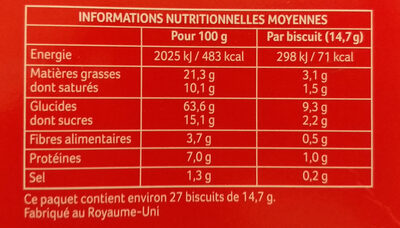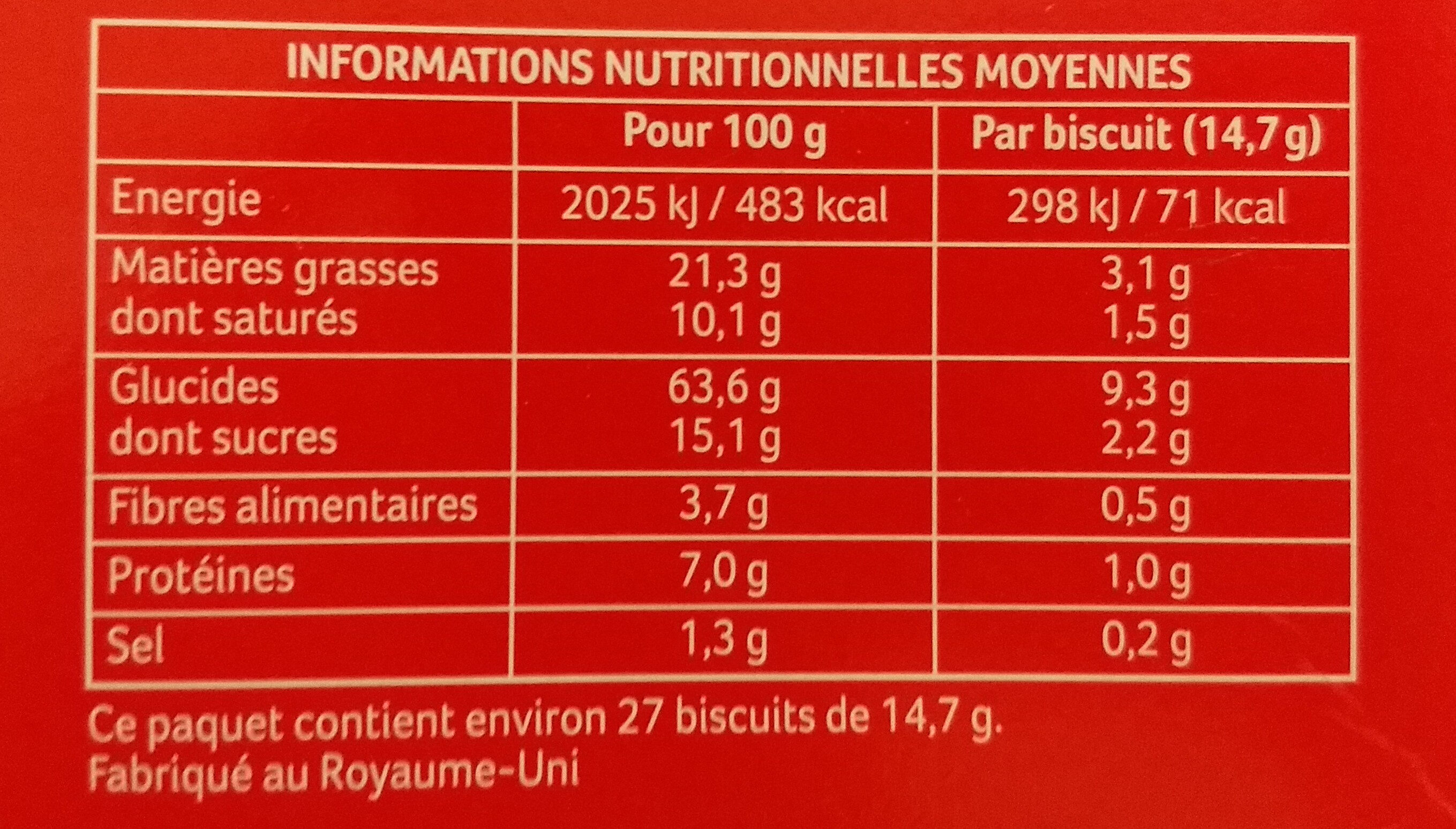Digestive biscuits - MCVITIE'S - 400 g
This product page is not complete. You can help to complete it by editing it and adding more data from the photos we have, or by taking more photos using the app for Android or iPhone/iPad. Thank you!
×
Barcode: 5000168198491 (EAN / EAN-13)
Common name: Biscuits aux céréales - Sablé Anglais The Original
Quantity: 400 g
Packaging: Plastic, Cardboard, fr:Film plastique à jeter, fr:Pensez au tri!, fr:Étui carton à recycler
Brands: MCVITIE'S, UNITED BISCUITS, MC VITIES
Categories: Snacks, Sweet snacks, Biscuits and cakes, Biscuits, Shortbread cookies
Labels, certifications, awards:
Vegetarian, No artificial flavors, Green Dot, No artificial colors, No colorings, Tidy man, Triman, No-colouring, Riche-en-cereales, Verified

Manufacturing or processing places: Royaume-Uni
Stores: Leader Price, Magasins U, carrefour.fr
Countries where sold: France, Réunion, Switzerland
Matching with your preferences
Report a problem
Data sources
Product added on by kiliweb
Last edit of product page on by jusdekiwi.
Product page also edited by beniben, bmortgat, danis1597, date-limite-app, driveoff, ecoscore-impact-estimator, fares, foodless, foodviewer, foodvisor, halal-app-chakib, inf, jenbobaggins, magasins-u, moon-rabbit, n-boidin1, off.79227df9-7cc0-4939-8f07-d7905bd1fb89, openfoodfacts-contributors, packbot, pled, quechoisir, roboto-app, scanbot, sebleouf, segundo, tacite, vincenzof, ysculo, yuka.RjQ4U0w1MG1sNmt6Z01VaDNUWFEzZmx6M3BQNFZGcU9LY2tnSVE9PQ, yuka.Rm84ZU1ibzZ0dllYZ3RoZzR4RDV4ZEJWbW9LSkFGeWVNYlkzSVE9PQ, yuka.SDU4dlRxUVRyZVFndWM4NnhoK1AwZjBxdzdHRVIxN3VOdkZQSVE9PQ, yuka.U0x3REtJMWNnT0VRdXNkbnp4ZUs0ZTV3NDZHdFlIS0hNUG9VSWc9PQ, yuka.UnE4TkZZRWQvZklqZ004M3dVdnIydjV4eExHQVlHeXVjTUFNSVE9PQ, yuka.Uy84RUw2OHMvcVVxbDhRdXJpbk4yZEJMNG9TN0JGL29BT1ZQSUE9PQ, yuka.VDQ0RENyZ3JnYUVwdi9NczVVTGJwZlphMXA2dFVXRHBKc29YSVE9PQ, yuka.VEkwcUNKMExvT1lQeE0wbTd3SFE1c0pJeXE2TVJsaThNZWRQSVE9PQ, yuka.VEljNEFJVWhudjlhaThZUjhFcldvZE40M0lPblRGTHVNdThmSWc9PQ, yuka.VGZrUERQVWNsK1V2bmZKdndBSDg0TUJONVpMelpVK3dFclJCSVE9PQ, yuka.Vm9RTk9ZUWhtS1kxeGN3QjV5dlN3TlorbUxTckRUdXROL1lBSWc9PQ, yuka.WW9rQVNLWlEvL1VwdFBKazF5cmwzTUprbk1TRVoxMjdEYnNwSVE9PQ, yuka.WXBnbEVQOElnZlVzc2ZFZDR6VE84STFyd0phcEFHNlhLT3hBSUE9PQ, yuka.WnJwZUw3d2hyNllIbjh3OG9RLzE4WU1yN0tXblIzanRJY2NCSVE9PQ, yuka.YUprRlA2UXhuUG95d2YwOHBCNys4K3hsOVphNFlsenFkTkU0SVE9PQ, yuka.ZXIwL0V2cGVwK2xhcXNVOTF4M3MxY2t1K1lDR1lqcVBDOU1iSVE9PQ, yuka.sY2b0xO6T85zoF3NwEKvlh1dAsTakxycMTz5pGyul9GFN4e0TfNRwIfFb6s, yuka.sY2b0xO6T85zoF3NwEKvlkAaUdX5kBjBDzzvkFCanue8JLD5MftQwrj8N6s, yuka.sY2b0xO6T85zoF3NwEKvlkhbCPrx827dCBvTsGSz3fmjBIbTS8kr_6zDEas, yuka.sY2b0xO6T85zoF3NwEKvlkl3UeXsojPBDz3vpUm7ndOhMqTUR40r-bPrLas, yuka.sY2b0xO6T85zoF3NwEKvll1dSYr3swjlNxXkxkPR4seAdJe4Su9Nz47XGKs, yuka.sY2b0xO6T85zoF3NwEKvllNmddGFhBTvCUTkum67x9aVI6a3Rupi8rGkYqo, yuka.sY2b0xO6T85zoF3NwEKvlm1padjvhz7uEBrvn0CV7NiBf83aS_588tWkFqs, yuka.sY2b0xO6T85zoF3NwEKvlmAabejVhDyVDg7goHO5-tyICr_qO4st7bamMKg, yuka.sY2b0xO6T85zoF3NwEKvlmJlSsPnvCnYDTn5wV-xx9CuD77lP99784PWLqg, yuka.sY2b0xO6T85zoF3NwEKvlmNLasj5_Bn4FUPvlU-C_4fVCI7BZ8F924rDYqo, yuka.sY2b0xO6T85zoF3NwEKvln1hfsiHgAjePhL6qXKuw-mXEZm2bftt45joMqg, yuka.sY2b0xO6T85zoF3NwEKvlnYed8DDhTvOFRnSqEGF3ei1ArbIeop92qjnLqg, yuka.sY2b0xO6T85zoF3NwEKvlnZCa9Dd_B7WHhDTlkCg3MvTcMfhXMBM0JLBaas, z075020.
Last check of product page on by beniben.












